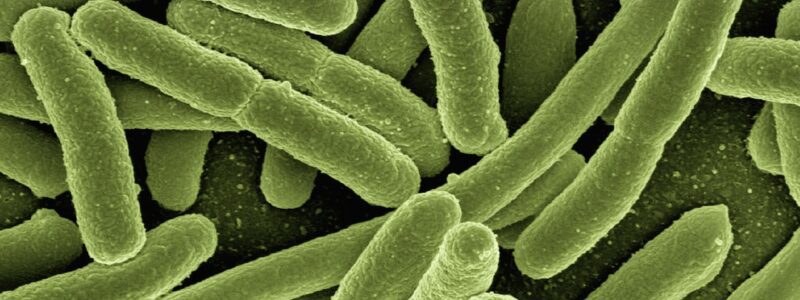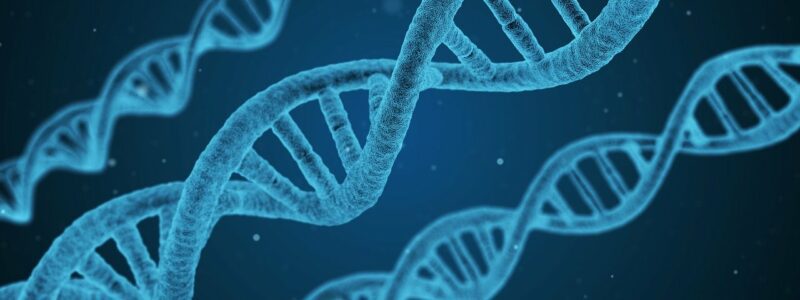Long Term Evolution Experiment

Typical bacteria – By This vector image is entirely made by Ali Zifan – Own work; used information from Biology 10e Textbook (chapter 4, Pg: 63) by: Peter Raven, Kenneth Mason, Jonathan Losos, Susan Singer · McGraw-Hill Education., CC BY-SA 4.0, Link.
The long-term evolution experiment is one of the most exciting studies on the feasibility of evolution to produce complicated metabolic systems and new systems of information within cells.
Evolution holds that mutations occur through natural processes which by chance, produce advantageous changes. These changes enhance the organism’s ability to survive and thus over time, become dominant within the population.
The problem with substantiating evolution is that these changes take considerable time to accumulate within a population and show a survival benefit.
Since people reproduce every 25 years, the time required to see inherited beneficial mutations accumulates with a human population could take thousands of years. This rate of change is far too slow for most life.
But bacteria reproduce much more quickly. For example, the common gut bacteria E. Coli doubles its population in about an hour. This rapid reproduction rate means multiple generations can be rapidly produced, allowing potentially beneficial mutations to accumulate.
The unanswered question was whether harmful mutations might also accumulate, producing decreased survival rates. A beneficial mutation might cause a population to reproduce quicker, but it might also enable damaging mutations to reproduce quicker as well.
Thus was born the Long Term Evolution Experiment. This remarkable experiment was started in 1988 by the evolutionary biologist Richard Lenski at Michigan State University. He tracked random genetic changes that occur over tens of thousands of generations of E. Coli as they multiply and divide. Thus, the bacteria go through about seven generations a day, producing more generations than a human could have in a million years!
The molecular biology experiment was to determine whether beneficial changes might occur over these thousands of generations. These beneficial changes might allow the bacteria to reproduce more quickly and over time displace their less well-endowed cousins.
They were especially interested in determining the nature of these beneficial mutations. Do they involve new biologic information with new metabolic pathways, or are they just rearrangement of genes already present. Do beneficial mutations outnumber harmful ones, and how do harmful and beneficial mutations interact with each other.
What they found would re-write the textbooks.
The Citrate Explosion
Results were disappointing initially – nothing much happened. Lenski considered shutting the whole thing down as an inconclusive experiment. However, it is burdensome – and expensive – to continue the investigation if there is nothing new to show for all that work.
But Lenski decided to persevere. His graduate students pushed for more time, and the sheer inertia of the experiment convinced him to continue.

Citrate
In 2008 after about 30,000 generations – it happened.
One of the E. Coli cell lines suddenly developed the ability to metabolize citrate. This chemical had been part of the culture broth for technical reasons and is not usually metabolized by the E. Coli bacteria.
Genetic analysis of this new ability showed that it was produced by duplicating and rearranging a gene for a protein that can import citrate into the cell when there is no oxygen present (in an anaerobic environment).
Evolutionists all over the world hailed this finding as a remarkable confirmation of evolution in the laboratory. Headlines proclaimed the experiment had “confirmed evolution.”
But what is the fundamental importance of this fortuitous occurrence, and does it indeed substantiate evolution?
Prior Confirmation
The Long Term Evolutionary Experiment is indeed important – but not for the reasons new media proposed by popular science. Instead, microbiologists cited other scientists who had been able to produce the same phenomena; Barry Hall, for example, had isolated an E. Coli mutant that could also metabolize citrate after only a few weeks of growth.
Lenski promotes the idea that many beneficial mutations have been noted during the decades of evolution observed in the E. Coli bacteria. But what is often not recognized is that most of these “mutations” which turn out to be “favorable” do not represent the acquisition of new information.
More specifically, these mutations do not involve the production of new metabolic pathways or new cellular factories. Instead, they represent a rearrangement of the information already contained within the DNA molecule. Sometimes this rearrangement produces no abilities but invariably sacrifices others.
Instead, the bacteria accumulated these new mutations to metabolize citrate because cellular repair mechanisms had stopped working. Indeed, the bacteria was sick. Yet, paradoxically, the unhealthy bacteria developed a survival advantage because one of the mutations not corrected by repair mechanisms enabled it to metabolize citrate.
The Lenski team writes concerning the new variant of E. Coli,
The spectrum of mutations identified in evolved clones was dominated by structural variation, including insertions, deletions, and mobile element transpositions.
These changes are likely to break or degrade genes – dozens of genes. The citrate mutant tossed genetic information overboard in an attempt to continue the short-term advantage of citrate metabolism.
It is like a teenager who found his father’s credit card and decided to run it up. There would certainly be a short-term advantage in whatever the youngster chose to purchase. However, there would be a very negative outcome when the father (inevitably) finds out.
Death of the Clones
The loss of cellular repair in the citrate mutant and the loss of genetic information resulting from failure of cellular repair produced unhealthy bacteria. This led to a death spiral in the citrate E. Coli colony. Although at the same time, the bacteria could metabolize citrate better than the “natural” E. Coli, mutations accumulated, eventually resulting in the bacteria’s death.

Michael Behe – By Campus Photo • Bryan Matluk – The Maine Campus Online, CC BY-SA 3.0, Link
Michael Behe would go on to write,
Interesting as it is, the ambiguous citrate mutation that started the hoopla is a sideshow. The overwhelmingly important and almost completely unnoticed lesson is that genes are being degraded left and right, both when they directly benefit the bacteria and when they do so indirectly in support of another mutation. The occasional, particularly noticeable modification-of function or gain of FCT mutation can’t turn back the tide of damaging and loss of FCT ones.
Summary of Long Term Evolution Experiment
The long-term evolution experiment has provided us with valuable insight into the evolutionary process at a practical level.
The experiment failed to demonstrate the evolution of any new information; there are no new metabolic pathways, no new information in DNA, no new fundamental advances in the cellular machinery of life.
Instead, what we witness is evolution through the loss of function or degradation. In the particular E. Coli involved, the cellular repair mechanisms of the bacteria were damaged such that random mutations tended to accumulate, eventually leading to an unhealthy bacteria with a crash in its colony.
A mutation did occur, again through the loss of function, that allowed the bacteria to metabolize citrate in the presence of oxygen – something the native bacteria can not do. But this new ability was not due to the acquisition of further information or new metabolic pathways. Instead, it was due to the degradation of already present data and the rearrangement of genetic material.
The bacteria ended up sacrificing itself to gain the ability to metabolize a chemical it usually could not, but this new ability would eventually lead to its demise.
Hardly a win for Darwinian evolution.





Wow, I actually understood this! Often times I’ve read things like this and they just went way over my head due to being too complex and wordy.
Thanks for making it clear enough for anyone to read. This was interesting.
What would you say is the most important thing for humans right now? Scientifically speaking.
I’d like to know your viewpoint.
L, Sammy
My views on what are the most important things for science to study are probably affected by my being a practicing physician.
We are making great strides in cancer research and also in heart disease, so I would say studying how to better treat, cure, and prevent these diseases would be the most important.
The new science of mRNA used for the COVID vaccines is amazing – it has the potential to fundamentally change how cancer is treated. I would like to see full speed ahead in research of this type. Peoples’ lives depend on this research – I do not know what else could be more important.
Dave.
Hello David! This is one detailed artcle. The work you put into this is appreciated. I think the idea of evolution really comes down to some very basic ideas of heredity, replication and competition despite A lot thinking of evolution as being about stuff with blood and guts and DNA and RNA and proteins. I do not mean to minimize the difficulty or costs, of the Long term evolution experiment, but I suggest that LTEEs might sometimes run in the background as team pursue other short-term projects
I am sure you are correct – it would take a large budget to run LTEE with lots of personnel but little in the way of science coming out. I am sure the investigators in this program are involved in other studies.